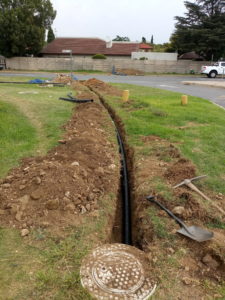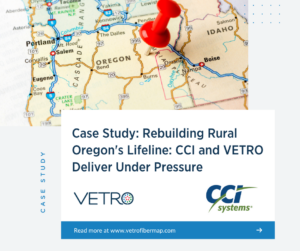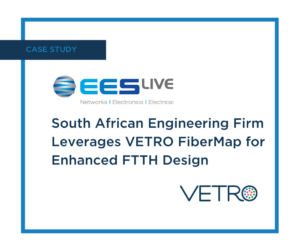TTConnect uses VETRO FiberMap to meet demand for open access fiber broadband networks.
TTConnect provides competitive open access fiber networks to homes, multi-unit dwellings, and businesses in Johannesburg, South Africa. Since its founding in 2015, TTConnect has more than quadrupled their client base, and now serves approximately 14,500 subscribers.
Fiber network expansion has already had a massive economic impact on South Africa. High speed internet has quickly become a necessity instead of a luxury, which means most residential and business real estate developments are advertised as fiber-ready to increase their value. However, about 80% of the existing network infrastructure in South Africa is copper-based, creating an aggressive demand for fiber optic network construction. Fiber is not sensitive to distance, and is ultimately the best option for reliable, quality broadband.
THE CHALLENGE

TTConnect Point of Presence
When TTConnect first began to build out their open access fiber last mile infrastructure, a single employee knew the historical network data—what infrastructure was in the ground, where it was installed, etc.—and field technicians often had to call into the office to confirm where to splice. No plans were created, even in spreadsheets, and there were no records to indicate what equipment was included in each build. TTConnect was rapidly expanding, but found it difficult to keep up with demand without a better way to record and organize network information.
Service issues were also difficult to troubleshoot; technicians relied on Google Earth kmz files to determine network routes, and map points were not always consistent with physical addresses. Additionally, TTConnect needed to be able to tell potential customers where they were going to build, as the company requires a 50% take rate prior to construction.
Without a solution to these bottlenecks, TTConnect’s growth was unsustainable. Deployment speed was critical to beating other ISPs to market. Proper planning and record keeping required a comprehensive network mapping platform.
THE APPROACH

TTConnect trenching work
Management at TTConnect considered other network mapping solutions, but selected VETRO FiberMap because it was the easiest platform to use, and it was available at a more cost-effective price point than other vendors. Douglas Williams, TTConnect’s Network Planner, was responsible for onboarding the solution.
“The support team understood what we needed. Changes were instant. Everything was customized. You can clearly see what’s going on in your network—that’s the awesome thing about VETRO FiberMap,” said Williams. “Larger software companies sell it to you ‘as is,’ but the VETRO FiberMap platform suits my needs.”
To help clarify network information, VETRO FiberMap offers custom color-coded icons that make it easier for management and individual users to check plans and understand network activity. This customization is critical to helping each employee learn and use the software efficiently.
Within two weeks, the TTConnect team was using as-built plans to load existing infrastructure into the VETRO FiberMap platform. From there, they worked alongside the VETRO FiberMap support team to begin planning new maps, and adding any necessary customization.
“It’s easier to adopt because people don’t need to change their processes to use the platform—the platform adapts to them,” said Williams.
THE RESULTS
When TTConnect implemented VETRO FiberMap, they instructed the surveyors, civil installers, and blowing and splicing teams not to go on site without a splicing diagram. The splicing diagram provides each team with clear direction, highlighting which route to use-—duct, route, fiber, patch panel, switch and Point of Presence (POP)—so any break in connectivity would be easily identifiable.
“The splicing diagram is awesome. It used to take 3-4 hours to find an issue with a port connection, but with VETRO FiberMap it’s instant,” says Williams. “Field technicians used to have to call IT to confirm where they should be installing service, where to splice, what tubes to use. It’s been 4-5 months since we’ve had any phone calls, which is a big relief to everyone. We’re moving through installations much more quickly.”
Before VETRO FiberMap, it took one person a full month to plan a 42km fiber build using Google Earth. Today, TTConnect can complete the same 42km fiber build in 10 days, and currently conducts approximately 38 surveys and 18 installations per day.
“The time savings are astronomical. We’ve cut down the time it takes to plan a build by 50% using the VETRO FiberMap platform. We’re finally able to keep up with demand,” says Williams.
Training has also accelerated. VETRO FiberMap’s user-friendly platform enables TTConnect to onboard new employees very quickly, even with little to no previous GIS experience.
“Everybody understands it, and everything is easier. Even someone brand new to the business is using it, with no background in GIS or telecom. She’s now one of our ‘VETRO FiberMap Specialists,’ says Williams. “In two weeks, she went from constructing one POP a week to two or three POPs a day.”
TTConnect started with seven contractors, and has now grown to employ 42. All maps, plans, and installations are completed using VETRO FiberMap, providing clear and accurate network asset documentation. These work flow improvements have supported TTConnect’s ability to differentiate themselves from the competition with their fast go-live timeframe. While other network providers might take anywhere from three months to two years to complete installation after trenching, TTConnect is able to deliver a two week turnaround.
Today, TTConnect has approximately 5,500 circuits inputted into the VETRO FiberMap platform, and they add close to 100 circuits per day. The company plans to input all 14,500 existing circuits by the end of the year, with similar new growth projected for 2020 onward. Their final goal is to serve 200,000 subscribers.


